Oscillation strain
+/- 0.01° to 20° (+/- 0.01° to 90° optional)
(+/- 0.14% to 280% (0.14% to 1260%))
MDR 3000 Professional
Entry model instrument in the Rubber Process Analyzer (RPA) technology. The MDR 3000 Prof. can be operated either in static testing mode (MDR) or also in dynamic testing mode (RPA).
-
Instrument description
MDR 3000 Professional
Static and dynamic testing
The MDR 3000 Professional is designed for measuring the viscoelastic properties of polymers and elastomeric compounds before, during and after cure. The acquired data gives exact information about advanced material properties, processability, cure characteristics, cure speed, and the behavior of the compound at the after-cure, as well as final compound dynamic mechanical properties.
The MDR 3000 Professional is a unique hybrid testing system; it can be operated in static testing (MDR) mode and with a single click in the MonControl Software, be switched over into dynamic testing (RPA) operation mode. This provides the highest possible flexibility to the user as the MDR 3000 Professional can cover everyday routine QC tasks by working like a normal static Moving Die Rheometer at highest accuracy, repeatability and reproducibility while offering full Rubber Process Analyzer testing capabilities for even complex R&D testing, allowing the user to program, execute and evaluate arbitrary test sequences with the included MonControl Software.
The instrument is equipped with MonTech‘s unique, patented direct precision drive system, offering variable oscillation amplitude and frequency along with precision temperature control, enabling testing according to almost every DIN / ISO and ASTM test standard in reference to Moving Die Rheometers and Rubber Process Analyzers.
Due to the rugged and flexible construction and various options such as cooling and automation, this device can be used for extended quality control and production monitoring purposes not only in the laboratory, but also directly on the shopfloor.
Automation options
All MonTech Moving Die Rheometers as well as Rubber Process Analyzers can be easily automated, allowing customers to increase productivity and release operators for other important tasks.
MonTech offers the worlds largest Rheometer Automation portfolio designed for our customers to rely on – in the lab or on the shopfloor, in multiple shifts, 365 days, every year. Depending on the selected type of automation system, samples are loaded and unloaded automatically from linear or rotary trays, film is fed and tested samples are removed automatically.
Of course, every automated machine can – within a single click – also be switched into manual operation mode.
Instrument options
For specific testing requirements MonTech offers a variety of instrument options to customize a testing solution exactly for your specific requirements:
– Forced air and low-temperature cooling systems
– Axial force transducers
– Cavity pressure control systems
– High speed data acquisition systems
– Data, IT and software integration
– Advanced productivity options -
Applications
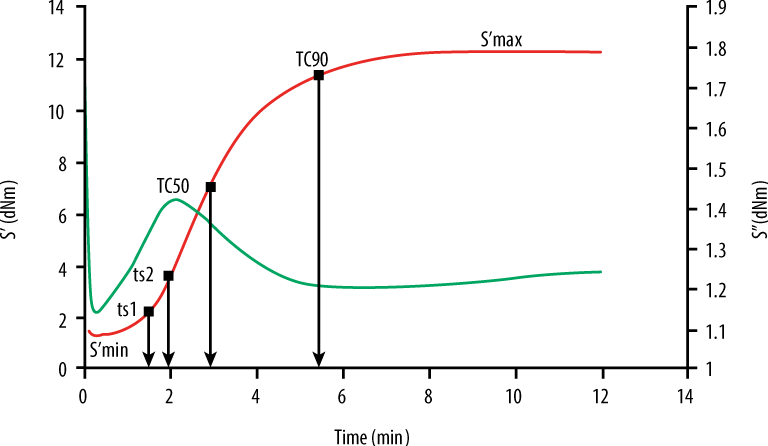
Isothermal Cure
Isothermal cure experiments are the most common type of test for quality control in rubber and elastomer processing. MonTech Moving Die Rheometers provide high precision data as well as a simple operation of the instruments. All the important characteristics, such as minimum / maximum elastic torque, scorch times, cure times and reaction rates are precisely calculated, with over 3500 different datapoints. All data is available in numerical as well as graphical form; limits, control gates and tolerance graphs can easily be set, and Pass / Fail status is automatically evaluated after each test.
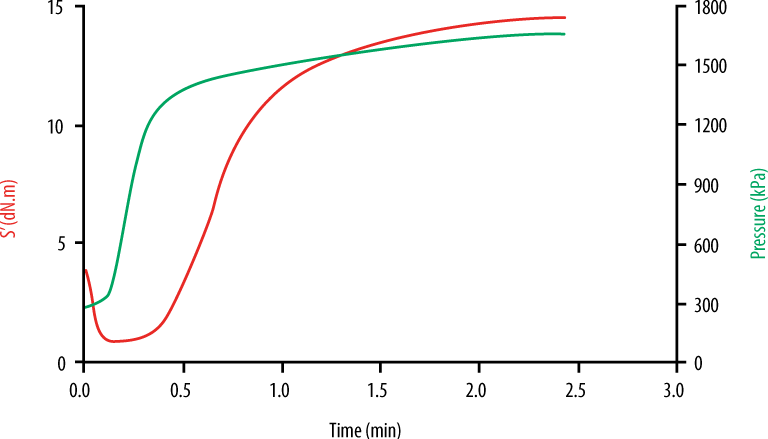
Cure with simultaneous Sponging / Foaming / Blowing Reaction
Especially for sealing applications, blowing agents form a vital part of compound recipes in order to produce a cellular structure via a foaming process that runs in parallel to the cure reaction. The cellular matrix structure which is created during the foaming process reduces density, increases thermal and acoustic insulation, and affects the relative stiffness of the mix. Therefore, MonTech Rheometers can be fitted with a precision normal force measurement transducer in the die cavity in order to calculate cavity pressure simultaneously during the curing and reaction in a single test, and revealing interrelations between the two reactions.
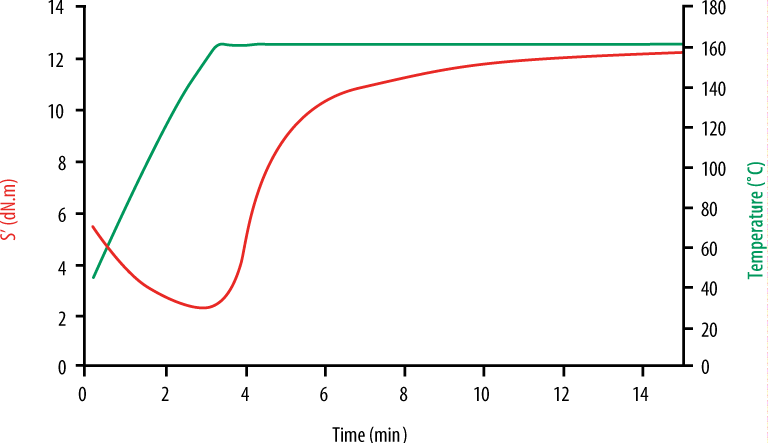
Non-isothermal Cure
In addition to isothermal static cure testing, MonTech MDRs and RPAs can perform tests at variable temperatures. These non-isothermal sequences can be programmed in order to follow virtually any temperature profile, making them especially valuable for the simulation of manufacturing processes which are usually not isothermal. Typical processes that can be simulated are mixing, milling, extrusion, compression moulding, injection moulding, and storage conditions. Of course, non-isothermal test sequences can be executed in a single test with any other static or dynamic sequence, such as strain and frequency sweeps, providing the most accurate data of the material‘s behavior at any production stage and material state.
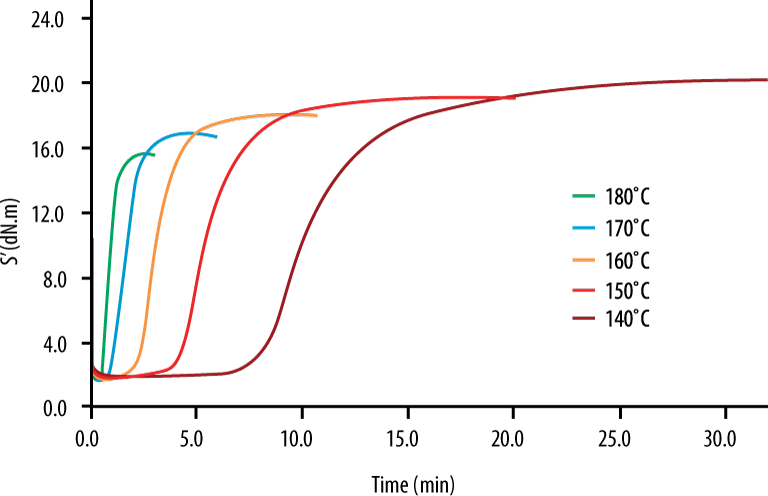
Advanced cure kinetics modeling
Test data from similar static or dynamic test sequences executed at different temperatures can automatically be evaluated and modelled for an advanced cure kinetics analysis, providing information about Reaction Rate, Order of Reaction (n), Rate Constant (k), Activation Energy (E) and Incubation Time (ti).
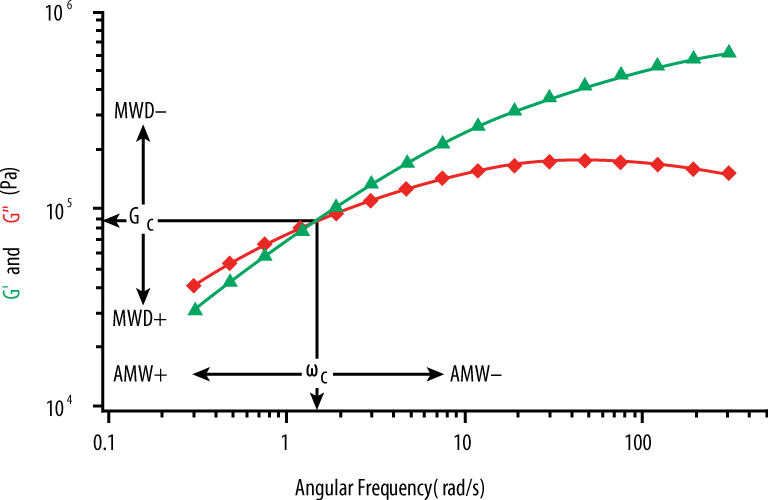
Frequency sweep material analysis
In general, the mechanical properties of materials depend on frequency. A good under-standing of the influence of frequency on a material is therefore very important for its practical use. For example, a material appears stiff under the action of a force at high frequency, but soft when the force is applied slowly. Isothermal frequency sweeps provide information about the weight distribution MWD (crossover modulus) as well as average molecular weight AWM (crossover frequency). But the behavior of viscoelastic materials like polymers not only depends on frequency, it also depends on temperature. MonTech has incorporated further advanced testing capabilities such as the Time-Temperature Superposition principle (TTS), which is based on the equivalence between frequency and temperature behavior during transition processes, forming the basis of WLF master-curve modelling available on MonTech dynamic Rheometers, even for predicting material performance at frequencies outside the range that can be measured with a dynamic mechanical analyzer.
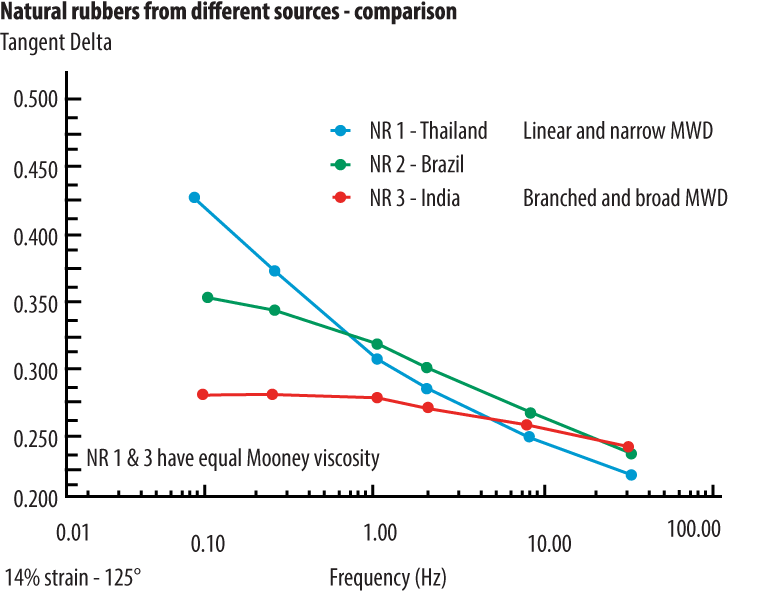
Structural characteristics and processability
The rheological properties of rubbers are related to their structural characteristics and will influence the behavior of the rubber during processing and the performance of the final product. While Mooney testing does not provide sufficient information to clearly differentiate branching and Molecular weight distribution the Rubber Process Analyzer can easily be used as a tool for solving production problems. Using frequency sweeps to scan the material over the whole shear rate range can reveal substantial material
differences and variations e.g. causing a particular material to be very sticky and therefore difficult to process while others can be perfectly processed.These test can be performed in the linear and also non-linear viscoelastic range to cover all different processing methods and material states. ISO 13145 suggests a simple and quick test procedure utilising a rotorless sealed shear rheometer (RPA) for rheological evaluations as an alternative to traditional Mooney Viscometer testing.
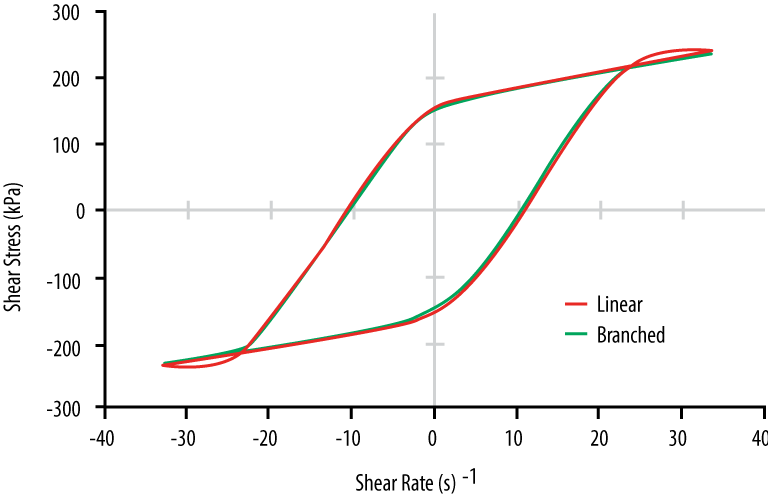
Non-Linear material response at high strain
Dynamic oscillatory shear tests are common in rubber rheology - more specifically, small-amplitude oscillatory shear (SAOS) tests are the most common test method for measuring linear viscoelastic properties of rubber compounds and polymers.
But in processing operations, the shear rates can be large and rapid; non-linear material properties form an even more important part in understanding material response. Therefore, MonTech Rheometers provide Fourier transformation analysis capabilities of periodic data, along with full raw-data access, for in-depth analysis to investigate and quantify the nonlinear viscoelastic behavior by using large-amplitude oscillatory shear (LAOS) testing in order to characterize and quantify material stress response which is no longer purely sinusoidal (linear), allowing a better understanding of filler content and structure, as well as the polymer architecture.
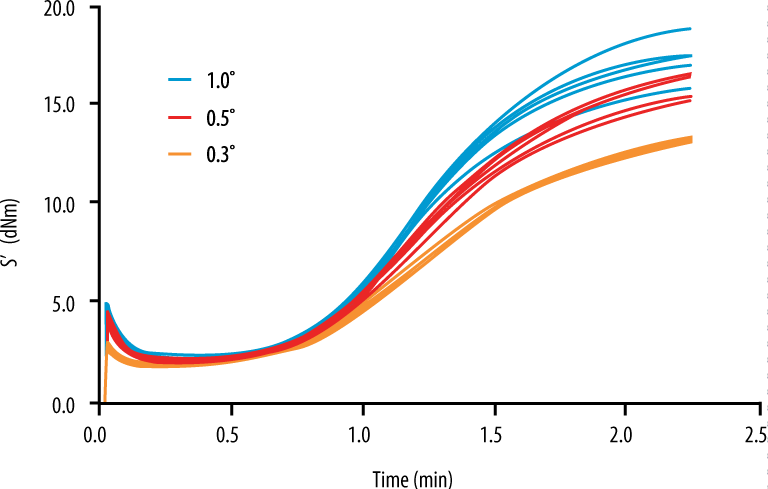
Isothermal Curing at Variable Strain
Typically, cure experiments on rubber compounds - especially for quality control purposes - are performed with a fixed oscillation angle of +/- 0.5° and a frequency of 1.67 Hz. However, for specific rubber compounds or challenging materials such as silicones or epoxy resins, this might not be ideal as either reaction torque readings are too low, providing only a limited ability to distinguish between different batches, or might be too high causing high result variability as the material is damaged as strain already exceeds the linear viscoelastic range. MonTech Rheometers provide the possibility of testing with variable oscillation angles to allow measurements within the ideal strain amplitude for optimal signal-to-noise ratio and the most precise test results, while avoiding any structural breakdown or slippage of the sample in the die cavity.

Structural Breakdown of rubber compounds - process simulation
Rubber compounds are extremely sensitive to processing operations such as milling. Increasing strain causes the carbon black network - which is held together by Van der Waals-London attraction forces to break, causing a decrease in shear modulus of filled rubber vulcanizates. Therefore, MonTech Rheometers provide simulation capabilities for almost any possible production process, providing irreplaceable data for developing rubber compounds, as well as understanding and simulating manufacturing processes and environments.
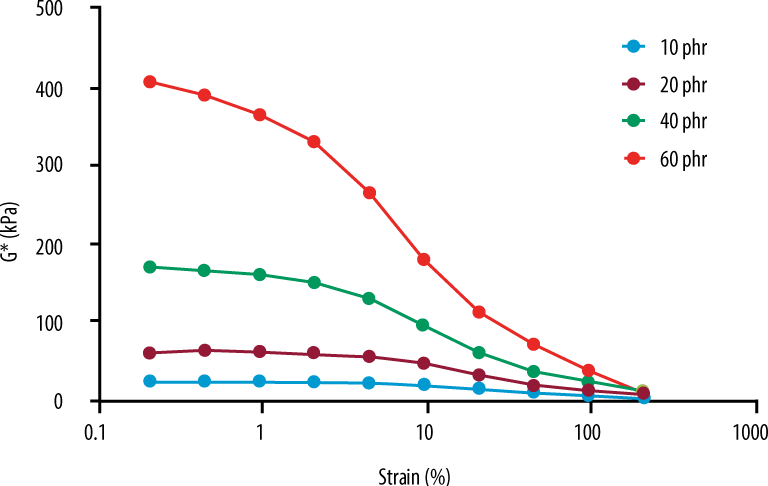
Strain Sweep for Filler Loading "Payne-effect"
The Payne effect is a particular feature of the stress-strain behavior of rubber, especially rubber compounds containing fillers such as carbon black and silica. Physically, the Payne effect can be attributed to deformation-induced changes in the material‘s microstructure, i.e. to breakage and recovery of weak physical bonds linking adjacent filler clusters.
Measurement of modulus vs. strain is therefore essential to understanding and quantifying filler loading, filler dispersion and filler-filler interaction in the low strain region, and polymer-filler interaction at higher strain. The resulting characterizations of material structure are essential as they directly impact dynamic stiffness and damping behavior of final products such as rubber bushings, automotive tyres and all other rubber goods. Similar to the Payne
effect under small deformations is the Mullins effect, which is observed under larger deformations in the non-linear viscoelastic range.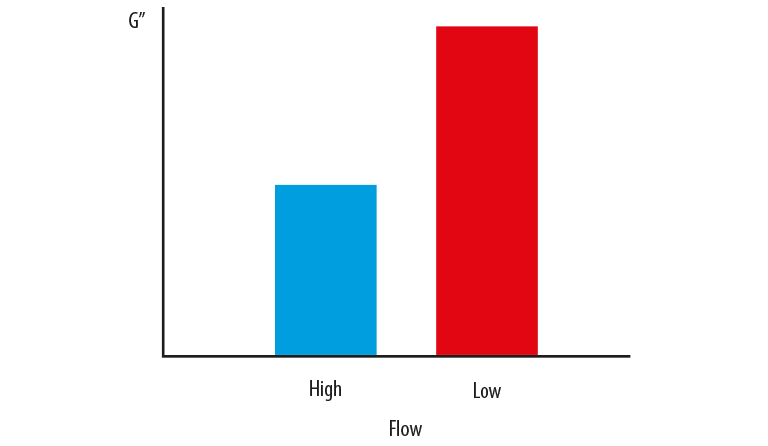
Prediction of processability: Extrusion
Good processing performance is influenced by three main criteria: throughput flow, die swell and surface finish. The rubber is required to flow through the extruder. The flow will be controlled by the viscosity of the rubber. The shear rate from an extruder and extrusion die can easily be calculated and used as the specific test parameters in a Rubber Process Analyzer test setup. The shear rate in MonTech Rubber Process Analyzer is proportional to the frequency multiplied by the oscillation angle.
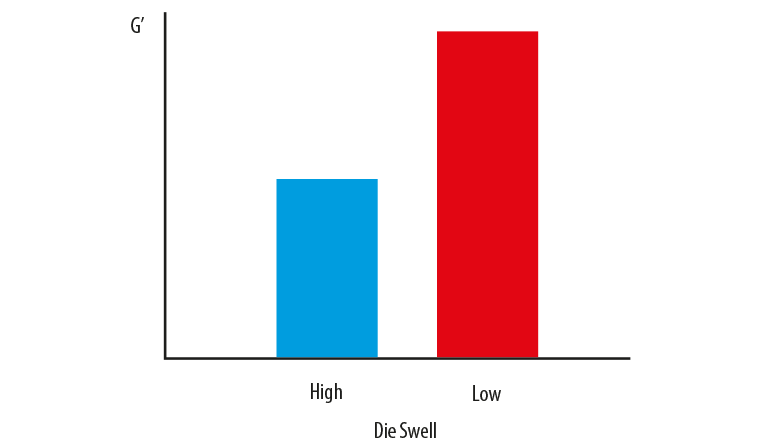
A low viscosity will mean than rubber will easily flow through the extruder with low die pressure. Once the rubber is extruded it is required to be in the correct size – however as the rubber is extruded through the die it is in compression across the direction of flow and extension in the direction of flow. When leaving the die, the elastic nature of the compound will cause the rubber to expand, resulting in die swell. MonTech Rubber Process Analyzers can obtain the Storage shear Modulus G' at high strains (typically 100%) allowing an excellent prediction of die swell.
The surface finish of the extrudate is required to be smooth, and not rough. Roughness tends to occur when a stick-slip resonance is set up between the speed of the extruder and the elastic response of the compound. Testing at variable shear rates using a frequency sweep allows the comparison of compounds that extrude with smooth and rough finishes revealing processing differences in the storage shear modulus G'.
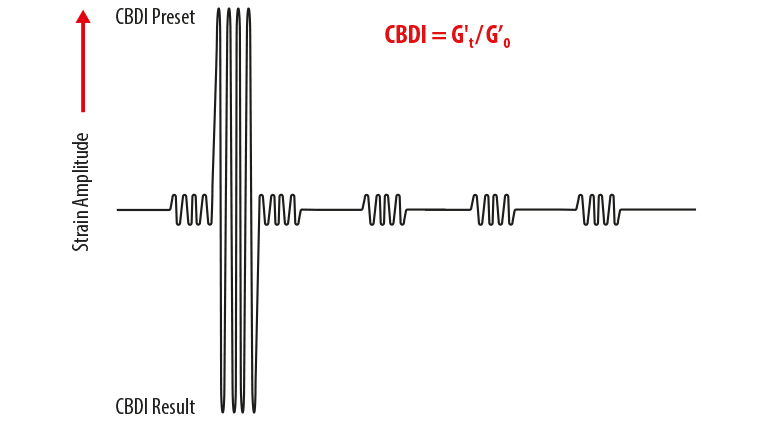
Mechanical properties: Carbon Black Dispersion
In filled rubber compounds carbon-black particles form a network of mutually interactive agglomerates. These effects can me measured and quantified using a simple D-RPA 3000 Matrix test. Storage shear modulus (G’) results at low strains (e.g. +/- 1%) are typically high and get reduced after a larger strain amplitude (e.g. +/-50%) is applied for a short period of time. With lower strain amplitudes applied over time, the reduced Storage shear modulus (G’) will partially recover. This effect relates to the Van der Waals forces linking the agglomerates, getting broken at higher strain amplitudes and the partially recovering over time.
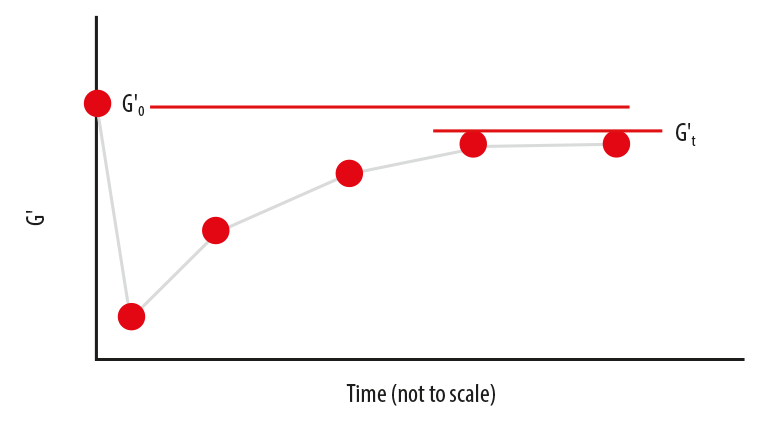
The extent of recovery of the Storage shear modulus (G’) directly relates to the Dispersion Rating (DR) of the rubber compound. If the carbon black is poorly dispersed, the recovery of the Storage shear modulus (G’) will be much lower indicating a much weaker filler structure and therefore reduced mechanical performance properties.
A simple CBDI performed by a Rubber Process Analyzer allows consistent testing and quality control on the Carbon Black Dispersion rating: CBDI = Initial storage shear modulus G’ (50°C, 1Hz, 1%) / Final storage shear modulus G’ (50°C, 1Hz, 1%). The higher the CBDI value, the better the carbon black dispersion.
-
Technical Specification
Technical Specification
-
International standards
ISO 13145 , ISO 6502, ASTM D 5289, ASTM D 6204, ASTM D 6601, ASTM D 6048, ASTM D 7050, ASTM D 7605, DIN 53529
-
Die configuration
Biconical, closed die system, sealed
-
Drive system
Direct, wearless servo drive system with ceramic bearings
-
Oscillation frequency
0.001 Hz to 33 Hz (0.001 Hz to 50 Hz optional)
-
Oscillation strain
+/- 0.01° to 20° (+/- 0.01° to 90° optional)
-
Temperature range
Ambient to 232 °C
-
Measured Data
Torque, temperature, frequency, strain; Optional: Normal force
-
Calculated Data
S΄, S˝, S*, G΄, G˝, G*, tan δ, η΄, η˝ and η*
-
Die gap
0.45 mm nominal
-
Sample volume
approx. 4.5 cm³
-
Closing system
Soft closing to prevent foil rips and damage of test sample
-
Torque range
0.001 to 250 dNm
-
Temperature control system
Ambient to 232 °C, precision +/- 0.03 °C, Max. heating and cooling rate: 85°C/min, digital, microprocessor controlled (Pneumatic double channel cooling system optional)
-
Temperature check system
Recordings of the temperature gradient on the screen, microprocessor monitored
-
Subroutines
Isothermal, Non-Isothermal, Timed, Temperature Sweep, Strain Sweep, Frequency Sweep, Shear rate Sweep, Relaxation, Retardation, Hysteresis, Tension tests, LAOS, ...
-
Data Interface
Ethernet (10/100 MBit), USB (int.), CF card (int.), RS232 (opt.)
-
Data points
Over 3500 data points available for each static subtest; Including S‘ Min, S‘ Max, TS 1, TS 2, TC 10, TC 30, TC 50, TC 90; Integrated, automatic reporting features for dynamic tests
-
Pneumatics
min. 4.5 Bar / 60 psi
-
Electrical
200 V - 240 V, 6 Amps, 50/60 Hz
-
Instrument options
- Instrument control panel with 5“ touchscreen display and printer - Adapted transducers for high or low-viscosity torque range - Normal force / Pressure measurement - Double channel forced air cooling system - Low-temperature cooling system MCool 10 /MCool -40 - Extended thermal range to +300°C - Autoloader 5 or 10 sample linear - Autoloader with 24, 48 or 100 sample tray or tray changers - R-VS 3000 constant volume sample cutter
Calculated Data
Parameter
-
-
Options
VS 3000
The VS 3000 universal constant volume cutter is the ideal and reliable sample preparation tool for applications that require constant volume samples such as preforms for moulding operations. The VS 3000 sample cutter can be fitted with knives of any diameter between 20 and 60mm per customer requirements, making the cutter an ideal tool for easy preform preparation in lab or production environments.
VS 3000R-VS 3000
The R-VS 3000 Rheometer sample cutter is designed for the fast, safe and easy preparation of Rheometer test samples with a constant sample volume, significantly reducing operational variability and increasing test result reproducibility.
R-VS 3000
Tray automation with either 24, 48 or 100 samples
With direct tray-to-chamber handling, the sample arm picks samples from the tray.
Specific Standard and Application Search
With our intelligent application and standard search you can find products for applications and DIN, ISO, ASTM, BS, AFNOR, JIS and TGL standards in a few seconds.